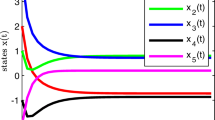Abstract
Equilibrium problems play a central role in the study of complex and competitive systems. Many variational formulations of these problems have been presented in these years. So, variational inequalities are very useful tools for the study of equilibrium solutions and their stability. More recently a dynamical model of equilibrium problems based on projection operators was proposed. It is designated as globally projected dynamical system (GPDS). The equilibrium points of this system are the solutions to the associated variational inequality (VI) problem. A very popular approach for finding solution of these VI and for studying its stability consists in introducing the so-called "gap-functions", while stability analysis of an equilibrium point of dynamical systems can be made by means of Lyapunov functions. In this paper we show strict relationships between gap functions and Lyapunov functions.
Similar content being viewed by others
References
Auslender, A. (1976), Optimisation: methodes numeriques, Masson, Paris.
Cavazzuti, E., Pappalardo, M. and Passacantando M. (2002), Nash equilibria, variational inequalities and dynamical systems, Journal of Optimization Theory and Application 114, 491–505.
Friesz, T. L., Bernstein, D. H., Mehta, N. J., Tobin, R. L. and Ganjlizadeh, S. (1994), Day-to-day dynamic network disequilibria and idealized traveler information systems, Operations Research 42, 1120–1136.
Fukushima, M. (1992), Equivalent differentiable optimization problems and descent methods for asymmetric variational inequality problems, Mathematical Programming 53, 99–110.
Hirsch, M. W. and Smale, S. (1974), Differential Equations, Dynamical Systems, and Linear Algebra, Academic Press, New York.
Kinderlehrer, D. and Stampacchia, G. (1980), An Introduction to Variational Inequality and their Application, Academic Press, New York.
La Salle, J. and Lefschetz, S. (1961), Stability by Lyapunov's Direct Method with Applications, Academic Press, New York.
Pappalardo, M. and Passacantando, M. (2002), Stability for equilibrium problems: from variational inequalities to dynamical systems, Journal of Optimization Theory and Application 113, 567–582.
Xia, Y. S. and Wang, J. (2000), On the stability of globally projected dynamical systems, Journal of Optimization Theory and Applications 106, 129–150.
Zhu, D.L., and Marcotte P. (1994), An extended descent framework for variational inequalities, Journal of Optimization Theory and Application 80, 349–366.
Author information
Authors and Affiliations
Rights and permissions
About this article
Cite this article
Pappalardo, M., Passacantando, M. Gap Functions and Lyapunov Functions. Journal of Global Optimization 28, 379–385 (2004). https://doi.org/10.1023/B:JOGO.0000026455.72523.ed
Issue Date:
DOI: https://doi.org/10.1023/B:JOGO.0000026455.72523.ed



